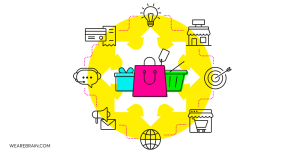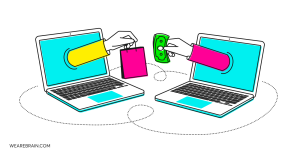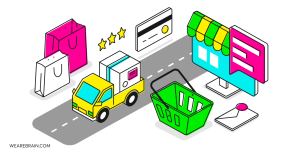How to future-proof your B2B e-commerce operations

Our adoption of automation in the workplace model reached a crescendo last year. The pandemic created the perfect case study to show how technologies can continue to drive business processes without much in-person human intervention. This marked a decisive and permanent global culture shift in the way we approach work, leveraging technologies to improve our business processes.
But adoption of new technologies means new approaches to traditional, in-person sales and marketing initiatives: as the technology evolves, so must our approach.
Gartner’s Future of Sales 2025 report shows 60% of B2B sales businesses will pivot from ‘experience- and intuition-based selling to data-driven selling’ by 2025. This is because most B2B buyers prefer to deal with suppliers via digital channels.
How the B2B buying journey has evolved
The B2B buying journey has undergone a radical transformation from what it was a few years ago. It is now clear that B2B businesses that have not yet digitally transformed their business strategy (and sales and marketing approach) must do so immediately before falling behind for good.
Much like B2C before it, the B2B space is being usurped by digital, which is rendering in-person interactions redundant. Countless studies show that B2B buyers begin their search for a product or service using a keyboard, so if they can’t find your business online you will miss out on being considered for the purchase.
Today’s digitally baptised buyers are more savvy and discerning than ever thanks to the abundant availability of information at their disposal. Many prefer to shop around online themselves than approach a salesperson for assistance, significantly reducing the opportunity to influence their purchasing decisions. In fact, most buyers only engage with salespeople once they are ready to make a purchase.
Gartner has found that when considering a purchase, buyers only spend 17% of their time engaging with potential clients (and only 5% when comparing suppliers).
Digital transformation is key to remaining competitive
If your audience is unable to find the relevant information they need about your product or service online quickly, they will disregard you in favour of your competitors before you even get the chance to entice a sale.
For businesses to make their mark in today’s world, it is essential to dive head-first into digital transformation.
Businesses must digitise their B2B sales and marketing, focusing on both strategy and execution using technology as accelerators.
Benefits of digitising B2B sales and marketing
- Remain competitive: In a world where technology and digital communications are pervasive, it is crucial to leverage the right technologies to remain ahead of the competition
- Fully remote: Digitising B2B sales and marketing allows businesses to effectively operate remotely during global moments of pause, such as lockdowns, environmental crises, post-pandemic realities, etc.
- Stay current: Adapting to a modern buyers’ journey helps businesses to understand any e-commerce customer’s (B2B or B2C) habits, frustrations, and approach.
- Streamline processes: Digitisation ensures refined, fast, and accurate business and operational processes that eliminate redundancies, especially while operating remotely
Outcomes of successful B2B sales and marketing digitisation
When armed with a solid strategy that leverages technologies, digitised B2B sales and marketing have the power to provide businesses with numerous benefits:
- High ROI: Not only are digital marketing and sales considerably more affordable than traditional methods, but they also promise high returns on investment within marketing budgets. B2B email marketing, for example, generates up to 4200% ROI on average.
- More customers: Digital marketing tools and processes can drive new customer acquisitions 10X more than traditional approaches. CRM marketing can also give you a better understanding of your customers and know better when and how to reach them.
- Seamless operations: Digitised sales and marketing processes drive operational excellence. When important technical elements are running smoothly, businesses have more time to focus on crucial areas where a human-centric approach is needed.
How to get started with a B2B marketing strategy
Developing and executing an effective B2B marketing roadmap takes a lot of consideration and effort. Luckily, the rewards of a successful strategy are worth it, by a long shot.
It is important to clearly define the what, why and who before the how. In other words: plan first, then execute.
Phase I: Set up
- Goals and objectives: Establish clear goals and objectives according to your business type as your strategy will vary depending on the market you wish to penetrate. Create an executive summary to guide you through the process.
- Mission statement and value proposition: Develop a brand identity by exploring your vision, mission, and purpose. These will help define your value proposition and brand purpose (what sets you apart).
- Target audience: You must know your audience well to be able to communicate with them successfully. Segment your market and then focus on a target segment. Then, create an ideal customer persona (ICP) for each segment so you know how to successfully communicate with each persona in each segment.
- Pricing and positioning strategy: The best way to remain ahead of your B2B competitors is to price your products or services correctly, according to the benefits they provide and the industry in which they function. Pricing will affect the perception of your product and/or service, including your business.
- Distribution and fulfilment plan: Having a strong and fail-safe distribution and fulfilment plan is of paramount importance to get right, because it only takes one unfulfilled order for a B2B buyer to leave your site, never to return.
- KPIs: It is essential to develop clearly defined KPIs to align your marketing strategy to ensure you are taking the right steps to achieve your goals. Read our article on the 6 essential e-commerce KPIs.
Once you have completed the foundational planning phase of your B2B e-commerce marketing strategy, it is time to move on to the tangible means you can deploy to engage and entice your audience.
Phase II: Execute
- Social media marketing: B2B buyers use social media too, so it is a good idea to invest in a robust social media marketing strategy to increase engagement and funnel leads to your e-commerce platform. A strong social media presence droves customer validation and opens new sales opportunities with social shopping.
- Content marketing: Improve your SEO and customer engagement with a solid content marketing plan. Generating your own meaningful content drives your search engine scores and helps educate buyers while also increasing your brand authority. This will make buyers consider you before your competitors when looking for vendors.
- Search engine marketing (SEM): Pay-per-click (PPC) campaigns, display ad campaigns, and product campaigns allow you to feature higher in search engine results. Another way to improve SEO rankings is to optimise your website for voice search.
- Email marketing: The potency of email marketing has evolved tremendously in recent years thanks to the power of automation. Providing engaging and valuable information to your customers, email marketing boasts almost inconceivable high ROI thanks to effective audience engagement.
- Affiliate marketing: Third-party/affiliate marketers leverage paid advertising and content marketing to either drive traffic to your site, or to promote and sell your product on their own site for a commission. The wider the reach of your content across various third-party websites and platforms, the better your visibility in search engines.
- User-generated content (UGC): When a buyer reviews your product or service and posts it online, they are actively promoting and marketing your business for free. Not only does this drive more traffic to your site, it also brings new buyers who are already interested in your business.
A strong B2B e-commerce marketing strategy must have the above elements to make any real impact. In short, you need to create cohesion between building a great website, integrating your campaigns, developing a strong social media presence, and leveraging analytics and reports to course-correct and build upon improvements.
By doing this thoroughly, you will soon be on your way to boosting conversions and generating more revenue.
Data-driven sales and marketing
Artificial Intelligence (AI) provides numerous opportunities to drive sales potency. Marketing AI systems handle repetitive administrative tasks leaving sales teams with more time to engage meaningfully with clients.
Businesses can benefit tremendously from the sustainable results and competitive advantages provided by Advanced Analytics, Predictive Planning and Machine Learning (ML). The data gathered from these MarTech processes gives marketing teams an abundance of important information to inform strategies.
Here are a few ways that data-driven sales and marketing can drive revenue:
- Dynamic pricing: Allows businesses to automatically implement flexible pricing structures based on market demand and customer behaviour.
- Predictive lead scoring: Utilises ML algorithms to analyse existing customers’ behaviour to forecast the probability that a lead can become a potential customer.
- Forecasting: AI and Predictive Analytics help to predict potential sales results based on probability models informed by data.
- Cross- and up-selling: AI and ML is leveraged to analyse customer data and buying habits to rank customers by their willingness to add additional products to an existing purchase.
- Customer satisfaction: Chatbots, virtual shopping assistants, 24/7 customer service, and analysing customer data all serve to create a customised buying experience that is intuitive to customers’ needs.
Businesses considering investing in robust sales and marketing software, such as SAP Marketing Cloud, will see a dramatic uptick in leads, customer satisfaction, and ROI.
According to numerous surveys, 80% of businesses experience increased leads and 77% see increases in conversion when using marketing software.
Summary
Digitising B2B e-commerce sales and marketing methods is no longer a nice to have but rather a prerequisite in the modern digital age. Automation is not only here to improve our everyday and business lives, it is also here to stay.
B2B businesses must undergo thorough digital transformation to adapt to the challenges of the current and future e-commerce business landscape.
Mario Grunitz
Related posts

Omnichannel strategy: Best of both (online & offline) worlds

Look before you buy: The AR & VR home decor revolution

Rewriting retail’s playbook: The rise of direct-to-consumer (DTC) brands

Level up your e-commerce playbook in 2024
Working Machines
An executive’s guide to AI and Intelligent Automation. Working Machines takes a look at how the renewed vigour for the development of Artificial Intelligence and Intelligent Automation technology has begun to change how businesses operate.



